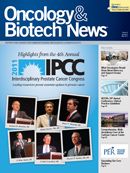NCCN's 16th Annual Conference: Clinical Practice Guidelines & Quality Cancer Care
Each year the National Comprehensive Cancer Network (NCCN) presents the latest updates to its Clinical Practice Guidelines in Oncology, as well as the latest cancer therapies by key opinion leaders.
Each year the National Comprehensive Cancer Network (NCCN) presents the latest updates to its Clinical Practice Guidelines in Oncology, as well as the latest cancer therapies by key opinion leaders. This year’s event, held at The Westin Diplomat in Hollywood, Florida, from March 9-13, 2011, featured two roundtable discussions: (1) “The Many Faces and Challenges of Caregivers” hosted by former ABC newsman Sam Donaldson (to watch the roundtable video in its entirety, go to http://bit.ly/hV6H5x); and (2) “Molecular Testing: Implications for Practice and Policy” hosted by Clifford Goodman, PhD, senior vice president of the Lewin Group.
In addition to the NCCN Guidelines Update sessions and the roundtables, there were other sessions on topics such as hepatitis B screening and chemotherapy, imaging techniques, and radiation oncology. However, it is the NCCN Guidelines Update sessions that generate the most attention and discussion.
According to an NCCN spokeswoman, there were nearly 1800 oncologists, fellows, nurses, pharmacists, and other healthcare professionals at the meeting. In a welcome letter to attendees, William T. McGivney, PhD, the CEO of NCCN, noted that the Clinical Practice Guidelines in Oncology are the “recognized standard for clinical policy in the oncology community.” According to McGivney, the NCCN’s Guidelines cover the treatment of more than 97% of all cancer patients.
A brief summary of the 2011 updates to the NCCN Guidelines are provided below by cancer type.

Breast Cancer
Robert W. Carlson, MD
Stanford Comprehensive Cancer Center Dr Carlson: “Considering there are limited options for women with metastatic breast cancer who have already received other therapies, [eribulin] is a noteworthy treatment option that the Panel felt was important to incorporate into the Guidelines.”
- Eribulin (Halaven) has been added as a preferred single-agent option in the treatment of metastatic disease.
- Denosumab (Xgeva) has been included in the guidelines as an additional option for the prevention of skeletal-related events.
- A footnote was added discouraging axillary lymph node dissection in certain women with early breast cancer and a minimal number of positive lymph nodes.
- Bevacizumab (Avastin), in combination with paclitaxel (Taxol), continues to be endorsed as treatment for patients with stage IV breast cancer.
- With available study results being “inconsistent,” Dr Carlson noted that testing for CYP2D6 polymorphisms in order to determine the efficacy of tamoxifen is not recommended at this time.

Multiple Myeloma
Kenneth C. Anderson, MD
Dana-Farber Cancer Institute
- The serum-free light chain assay and the fluorescence in situ hybridization (FISH) for 1q21 amplification are now a recommended part of the initial diagnostic workup.
- The combination of bortezomib/ cyclophosphamide/ dexamethasone has been added as primary induction therapy for transplant candidates.
- The bortezomib /dexamethasone combination and the melphalan/ prednisone/lenalidomide combination have been included as therapy for primary induction for nontransplant candidates.
- The combinations of bortezomib/ cyclophosphamide/ dexamethasone and cyclophosphamide/ lenalidomide/ dexamethasone are now recommended for salvage therapy.
- The combinations of bortezomib/ dexamethasone and cyclophosphamide/ thalidomide/ dexamethasone have been added to the guidelines as initial treatment for amyloidosis.

Melanoma
Daniel G. Coit, MD
Memorial Sloan-Kettering Cancer Center
- Following the conference, the FDA approved ipilimumab (Yervoy) for the treatment of metastatic melanoma. On April 1, the NCCN added ipilimumab to the guidelines as a category 1 (ie, based on high-level evidence from randomized controlled trials) treatment option for patients with advanced or metastatic melanoma, although a footnote was added to warn of possible significant immune-mediated complications.
- Mitotic index, the single most important predictor of survival according to Dr Coit, now replaces Clark level in defining clinical stage IB melanoma.
- The guidelines have been updated to note that routine imaging is no longer recommended for stage IIa melanoma patients with negative lymph nodes. Previous guidelines noted that this decision was left to the discretion of the clinician.
- A new footnote was added to the section regarding the use of interferon alfa in the adjuvant treatment for stage III disease (sentinel node—positive or clinically positive nodes), indicating that the drug can be given as high-dose interferon for 1 year or peginterferon alfa-b for 5 years.
- Although there is no hard and fast rule about which patients should have one, physicians should discuss the possibility of sentinel lymph node biopsies with patients who have stage IB or stage II disease.

Head and Neck Cancer
David G. Pfister, MD
Memorial Sloan-Kettering Cancer Center Dr Pfister: “Data indicate that HPV presence is associated with an increased risk of oropharynx cancer independent of tobacco or alcohol use.”
- The guidelines now suggest that patients with oropharyngeal tumors be tested for the human papillomavirus (HPV).
- The issue of induction theory remains contentious, so the guidelines have not changed. However, the ongoing DeCIDE trial is expected to determine whether induction therapy is beneficial.
- The patient management part of the guidelines has been made more user-friendly. These changes include a staging update to reflect the seventh edition of the AJCC Staging Manual, a revised order for the primary site algorithms, a change to make the workup sections more consistent, and the addition of the “Principles of Surgery” section.
- The guidelines also suggest that patients with hypopharyngeal cancer be evaluated and started on speech therapy as soon as possible to avoid severe speech impairment as the disease progresses.

Chronic Myelogenous Leukemia
Susan M. O'Brien, MD
University of Texas MD Anderson Cancer Center Dr O’Brien: “For newly diagnosed patients, all three TKIs [tyrosine kinase inhibitors] recommended in the NCCN Guidelines are viable treatment options. Selection of appropriate TKI therapy will depend on the stage of the disease, the agent’s side-effect profile, and its relative effectiveness against BCR-ABL mutations.”
- The second-generation TKIs nilotinib (Tasigna) and dasatinib (Sprycel) are now recommended as first-line treatment for CML.
- In monitoring response to therapy, complete cytogenic response remains the gold standard; however, not achieving complete molecular response should not be considered as treatment failure.
- Although not yet included in the guidelines, the TKIs ponatinib and bosutinib are showing promise, according to Dr O’Brien.

Myeloid Growth Factors
Jeffrey Crawford, MD
Duke Cancer Institute
- A revised footnote to the guidelines now states that there is a slight excess risk of acute myeloid leukemia and myelodysplastic syndromes in patients who have received colony-stimulating factors for chemotherapy-associated febrile neutropenia.
- The guidelines now recommend that primary prophylaxis with G-CSF should be considered in patients who receive cabazitaxel chemotherapy for metastatic prostate cancer.

Non-Hodgkin’s Lymphoma
Andrew D. Zelenetz, MD, PhD
Memorial Sloan-Kettering Cancer Center Dr Zelenetz: “Despite recent advances, it remains a major challenge to define indications for preemptive therapies for posttransplant lymphoproliferative disorder and to integrate novel therapeutic approaches with conventional therapies. The NCCN Guidelines now help to provide a solid framework to assist in diagnosis and treatment decisions.”
- A new guideline has been added for post-transplant lymphoproliferative disorder; recommended treatment options include reduction of immunosuppression, single-agent rituximab, and chemoimmunotherapy.
- The combination of rituximab and bendamustine (Treanda) is now recommended as first-line therapy for follicular lymphoma.
- The updated guidelines indicate that PET scans might be useful in certain patients with grades 1 to 2 follicular lymphoma.

Non—Small Cell Lung Cancer
David S. Ettinger, MD
Sidney Kimmel Comprehensive Cancer Center at Johns Hopkins Dr Ettinger: “Histology matters in non—small cell lung cancer.”
- The evaluation process for non—small cell lung cancer (NSCLC) now requires that the disease’s histologic subtype (ie, adenocarcinoma, large-cell carcinoma, NSCLC not otherwise specified) be established before continuing with epidermal growth-factor receptor (EGFR) testing. The testing is not recommended for squamous cell carcinoma, which has an incidence of EGFR mutations of less than 3.6%.
- A new clarification to the guidelines states that erlotinib (Tarceva), recommended as the first-line systemic therapy in patients with 3 histologies (ie, adenocarcinoma, large-cell carcinoma, and NSCLC not otherwise specified) and a positive EGFR mutation, is for patients with a 0 to 4 performance status. The updated guidelines also include gefitinib as first-line therapy in these same patients.
- The guidelines state that NSCLC patients should be tested for KRAS mutations, as these mutations are associated with tyrosine kinase inhibitor (TKI) resistance, thereby limiting the effectiveness of TKIs like erlotinib and gefitinib.
- For patients not at high risk, the guidelines do not recommend routine lung screening tests with computed tomography until more data are received from clinical trials on risks and benefits.

Sarcoma
Margaret von Mehren, MD
Fox Chase Cancer Center
- A new observation pathway has been added to the resectable desmoid tumors section of the guidelines. Watchful waiting is less controversial with desmoid tumors because they do not metastasize as prostate cancer does.
- Also added to the resectable desmoid tumors section of the guidelines is a new treatment pathway, which includes the options of surgery and/or radiation therapy and/or systemic therapy.
- The NCCN staging system for sarcomas now classifies lymph node involvement as stage III, not stage IV.
- Molecular profiles and markers will become increasingly important to aid in the diagnosis, prognosis, and treatment of sarcomas.

Prostate Cancer
James L. Mohler, MD
Roswell Park Cancer Institute Dr Mohler: “The NCCN Guidelines Panel remains concerned about overdiagnosis and overtreatment of prostate cancer as growing evidence suggests that overtreatment of prostate cancer commits too many men to side effects that outweigh a very small risk of prostate cancer death.”
- Active surveillance (ie, watchful waiting) was made more rigorous for men with low-risk prostate cancer.
- Sipuleucel-T (Provenge) has been added to the guidelines as an immunotherapy for asymptomatic or minimally symptomatic castrationrecurrent metastatic prostate cancer. Symptomatic men, however, are not candidates for sipuleucel-T and should be considered for docetaxel/ prednisone chemotherapy.
- Cabazitaxel (Jevtana) has also been added as a new second-line therapy for men with castration-recurrent metastatic prostate cancer who have failed docetaxel.
- As an alternative to zoledronic acid (Zometa), denosumab (Xgeva) is now recommended for the prevention of skeletal-related events.

Ovarian Cancer
Robert J. Morgan, Jr, MD
City of Hope Comprehensive Cancer Center Dr Morgan: “Regardless of the type of cancer, the NCCN Guidelines for Ovarian Cancer reflect the importance of stage and grade of disease on prognosis and treatment recommendations.”
- Dose-dense paclitaxel has been added to the guidelines as a category 1 treatment option for first-line treatment of stage II, III, or IV epithelial ovarian cancer.
- Intraperitoneal (IP) chemotherapy should now be used in patients with stage III disease. Also, IP can be used in optimally debulked (ie, tumor ≤1 cm) stage II patients.
- The guidelines continue to recommend that borderline epithelial ovarian cancer with low malignant potential be managed primarily by surgery. For women who want to remain fertile, surgery limited to unilateral salpingo-oophorectomy is still recommended. For those for whom fertility is not important, the guidelines continue to recommend standard ovarian cancerdebulking surgery.
- Bevacizumab (Avastin) is not yet recommended as upfront therapy with carboplatin/paclitaxel or as maintenance therapy.
- Although biomarkers continue to show promise in predicting future patterns of disease, the data on the utility of routine monitoring of CA-125 levels are inconclusive at this point. As a result, the guidelines encourage clinicians and patients to discuss the pros and cons associated with the routine monitoring of CA-125 levels.




